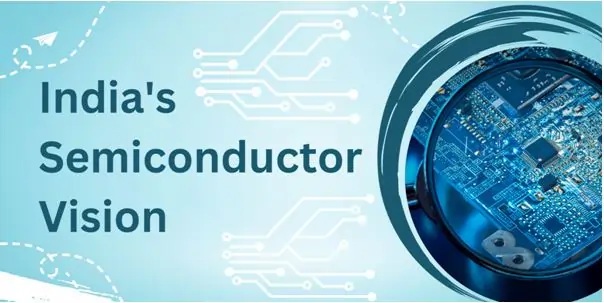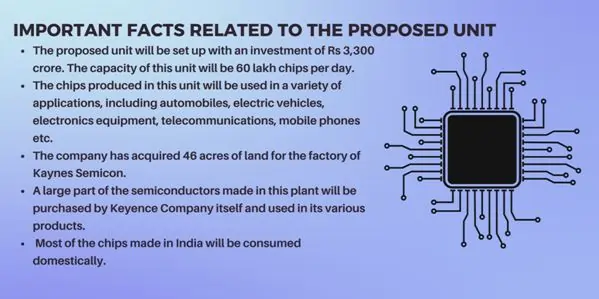
Approval has been given to KaynesSemicon Private Limited to
set up a semiconductor unit at Sanand, Gujarat under India
Semiconductor Mission (ISM). The Union Cabinet chaired by
the Prime Minister Shri Narendra Modi has approved the proposal
of KaynesSemicon Private Limited to set up a semiconductor unit
at Sanand, Gujarat. It aims to develop a complete semiconductor
eco-system in India under India Semiconductor Mission (ISM).Although
people are aware of them, these little masterminds of modern tech
know are the silent invisible heroes known as semiconductors.
It goes without saying that these small electrical components
are factory-installed pieces that have become an essential part
of everyday technologies from cellular phones to space-station
satellite assemblies.
Government of India's contribution in the development of semiconductor eco-system:
- The Government initiated many programs to Development of Semiconductors.
- The objective of this program was to provide attractive incentive support to companies/associations engaged in silicon semiconductor fab, display fab, compound semiconductors/silicon photonics/sensors (including MEMS) fab, semiconductor packaging (ATMP/OSAT), and semiconductor design.
- Announcement of setting up a special and independent "India Semiconductor Mission (ISM)" with the objective of pursuing long-term strategies to develop a sustainable system of production of semiconductors and displays.
- India Semiconductor Mission was established as the nodal agency for efficient and smooth implementation of schemes based on semiconductors and display systems.
- The Union Cabinet approved the first proposal to set up a semiconductor unit at Sanand, Gujarat in June 2023.
- Three more semiconductor units were approved in February 2024.

Development of Semiconductor Eco-system in India
- In June 2023, the proposal of US Company Micron to set up a semiconductor unit at Sanand was approved.
- Out of the three units approved in February, 2024, two units are a semiconductor fab being set up by Tata Electronics at Dholera, Gujarat and a semiconductor unit at Morigaon, Assam.
- The third unit is being set up by CG Power at Sanand, Gujarat.
- The construction of all the 4 semiconductor units is going on at a rapid pace and a strong semiconductor eco-system is emerging near the units.
- These four units will bring an investment of about Rs 1.5 lakh crore.
Chronology of India’s semiconductor journey
The evolution of India in the semiconductor domain has been a periodic story of accomplishments and orientations of development policies. Let’s explore the timeline from key moments to recent developments:
1974 - Early Beginnings:
The Indian semiconductor story began way back in 1974 when India was coming to term with the necessity of building up design and fabrication capacities of semiconductors with the assistance of the then Department of Electronics.At this time, a few firms have started the production of germanium semiconductors.
1980s - Rajiv Gandhi Era:1980s - Rajiv Gandhi Era:
In the 1980s, under Prime Minister Rajiv Gandhi, some policy measures were taken in direction of indigenous technology and self-reliance.India had significant progress in the field of semiconductor and that had attracted global players.
2020s - India Semiconductor Mission (ISM):
India has since early 2021 set out on a journey to develop a semiconductor industrial base.The India Semiconductor Mission (ISM) was launched with No subsidy offered previously and an overwhelmingly positive business environment for large players.
2024 - Dawn of India’s Semiconductor Era:
India is trying to establish its roots in the global supply chain. There are opportunities that emerged from geopolitical risks and shifting away from China.India wants the country to be the global supply-chain hub to support research, development, semi-conductor chip design, fabrication and nurturing the talent pool.
Future - Self-Reliance and Global Impact:
India’s aim is to produce 50,000 units per month, thus it plans to start production of the first chips by 2026.Future of semiconductor in India will majorly drive from strategic partnership, infrastructure development and skilled workforce.
.webp)
Understanding Semiconductors
What Are Semiconductors?
Semiconductors are the materials which are intermediate between the conductors and insulators materials, like metals and ceramics respectively. Its conductive ability it is in the middle that is why it’s called a semiconductor.Thus, the most used semiconductor material is silicon (Si) on which most electronic equipment are based.
- Energy Bands and Electrons:In a solid material the electrons are not randomly distributed over the non-allowed energy states or levels, but they are fixed. The valence band comprises of the electrons found in a material that effectively contributes to bonding and the conduction band that accommodates the mobile electrons.Semiconductors have what is called band gap which is the energy between the valence band and the conduction band. This gap enables them to carry electricity under certain conditions.
- P-N Junctions and Diodes: Well, some basic components are P-N junctions which are the result of the connection of a positively doped semiconductor, called p-type, and a negatively doped semiconductor, called n-type.Diodes that are formed utilizing P-N junction are those that permit the flow of current only in one direction.
India's semiconductor manufacturing capabilities:
- Current State:India at large has been acclaimed more for the software abilities but hard ware abilities have not been up to the mark.Due to the poor systems put in place for the manufacturing of semiconductors, the manufacturing sector still contributes only 17% of the GDP today as it was in 2010.
- Recent Developments:India is now racketing up its semiconductor plans. This it seeks to take the industry of semiconductor manufacturing of the global stage within the next five years.Taking advantage of its unmatched design skills and providing large incentives around 10 billion USD, India wants to persuade manufacturers to set up advanced fabs and manufacturing facilities.
- Strengths:India has a suitable workforce in the design of the semiconductor. At present, it contributes almost 20% of the global integrated circuit designs, covering more than 125000 skilled employees.The country is strong in design and it wishes to support this by venturing more into manufacturing.
- Challenges Ahead:Semiconductor fabs that are fabrication facilities entail very huge capital investments and rather solid structures.Stringent competition directly lies from megastar players of course including Taiwan, South Korea, and People’s Republic of China.
- Strategic Partnerships:India and the United States have started cooperation with this method through the Critical and Emerging Technology initiative (iCET). This is to increase strategy technology partnerships and cooperation in semiconductor ecosystems. The U.S.-India Semiconductor Supply Chain and Innovation Partnership builds the relationship even more.
Currently issue faced bysemiconductor industry in India
- Skilled Labour Force:A major challenge is attracting and sourcing for the best talent in the current and ever-changing market. All, however, concurred that a ready supply of engineers is available in India but specialized talents in semiconductor design and fabrication and testing arch.
- Infrastructure:The production of semiconductors is a process that needs clean spaces, the environment in terms of both temperature and humidity. These facilities are costly to establish and to provide.It is therefore important that uninterrupted qualitative power supply to the clean rooms is maintained and this in turn requires subsidy from the government on electricity.
- Import Dependency:Nonetheless, India’s semiconductor industry still has a long way to go the country relies on imports to get the materials and equipment needed for creating these chips.This can be solved by lowering of customs duties and encouraging the local manufacturing industries to produce more.
- Market Uncertainty and Consumer Demands:The consumer trends and technology in the industry of semiconductors are characterized by dynamic flux.It’s really a game to identify market trends while ensuring you do not incur high cost.
- Sustainable Waste Disposal:Manufacturing of semiconductor involves producing hazardous wastes. Disposal and environmental aspects can and should be considered as major issues.It means that it is high time to work out sustainable ecological principles and effective waste treatment technologies.
- Global Competition:Some of the biggest players are Taiwan, South Korea & China and most of the manufacturing is done on these countries.India must go out into the international market and fight for the investments if it has to make its stand.
However, there are some challenges that one can find in the India vision of semiconductor industry. Recently the Indian government has focussed on initiatives to develop the semiconductor market and collaborated with industries, making a long-term plan to set up a silicon factory in the country.
Way Forward
The challenges faced in the development of the semiconductor industry in India needs to be addressed with a systematic approach from all the stakeholders. Let’s explore some strategies:
- Government Support and Policies:Government should implement proper policies, fund and administrative reforms and conditions that would facilitate the manufacturing of semiconductors.Tax incentives, financial hand-outs and subsidies for establishment of fabs and other related facilities may induce investment and spur development.
- Infrastructure Development: As many have noted creating strong and stable structure is important. This comprise of availability of electricity, water supply and good network transport system.It is suggested that clusters of fabs should be established with reference to factors such as seismic risks and easy access to airports and customs officers.
- Skilled Workforce: It remains critical to build up talent capital as a source of skilled people. Thus, India must emphasize on developing expertise in the micro and nano electronics design, fabrication and testing technologies.Employment gaps can be closed with the help of partnership with educational institution and industry specialists.
- Reducing Import Dependency: India’s industry currently faces a challenge of having to import most of the materials and equipment. This is true because reducing import duty on items related to semiconductors will promote domestic production.Promoting indigenous production and innovation can serves to minimize the reliance on third party vendors
- Strategic Partnerships: Have strong cooperation with international counterparts, universities and industry associations. Bilateral coalitions and sharing of technology can go a long way in advancing the achievement of these goals.The large reservoir of talent available in India would want to leapfrog the challenges that are faced in other countries and this can be done by leveraging the international expertise.
- Environmental Sustainability: waste management and the effects on the environment should be considered at first place. Use environment friendly methods and ensure compliance with international standards.Such sustainable manufacturing strategies in the production of semiconductor products shall improve the perception of India globally.
- Public-Private Collaboration: Encourage private sector participation. PPs can promote innovation, investment and knowledge transfer in health care facilities.Members of an industry can be brought together through associations or forums to help them open up and discuss.
So, establishing semiconductor ecosystem is going to be a long drawn out process and not a short term achievement. Collectively with right strategies, planning, and determination these onslaughts can be warded off and India can indeed emerge as a semiconductor hub.